By Elizabeth Marney.
Leonora Carrington, most famous for her ground breaking additions to surrealist painting and literature, steadfastly maintained that she was never born, she was made. On an otherwise ordinary day in 1917, in the Lancashire mill town of Chorley, Carrington’s mother, left bloated and uncomfortable by overindulging in decadent foods, lay herself upon a machine. This particular machine had been designed to extract hundreds of gallons of semen from all the animals you could possibly imagine and, from this joining of human, animal, and machine, Leonora was created. This playful, disturbing anecdote encapsulates Carrington’s work and personality. Through her life’s work we see consistent subversion and parody of gender, posthumanism, and madness – all presented in the most brilliantly jarring way.
Whilst a patriarchal society may have brought us a breadth of insight from Carrington, it has left her often dismissed as a muse to the mainly male surrealist posse of the 20th century. Her time spent as Max Ernst’s companion or as ex-debutante is never far from conversation when an art aficionado is around. Carrington’s work was undeniably influenced by these things. Her most famous short story, The Debutante, contains an obvious nudge towards her past and her hunger to escape high society. A child debutante befriends a hyena and asks it to take her place at the ball. The hyena tears the face of the child’s maid, donning it as costume whilst the narrator remains willingly encaged in her room. After a snide remark is made at the ball towards their smell, the hyena rips off its fleshy mask and escapes through the window. Humanity is no more than a pageant of manners and materials. One need only decorate oneself and behave “like a human” in order to be accepted as a human. Whilst the turbulent emotions that she experienced in early adulthood greatly informed her work, it seems slightly absurd that a woman who escaped from involuntary incarceration in a sanatorium on a submarine is best known anecdotally for being on the footnotes of an ex-lover’s life.
What is the use of surrealism if not to point out the madness in normality? Carrington dissolves the distinction between human, animal, and machine with diligence and decadence. There is a great merging of everything: mysticism, class consciousness, plants and animals, humans, chimeras, rotting meat. There is no hierarchy among living things; in fact, humans are frequently the butt of the joke. Carrington’s posthumanism undermines anthropocentrism by various means. By relentlessly highlighting that violence is inherent in all life, Carrington undercuts humanism’s false benevolence. In exposing the self-deception and charlatanry inherent to science and religion, Carrington articulates logic and reason as little more than misplaced coping mechanisms.
There seems to be little qualm throughout Carrington’s work that humanity is a harbinger of death and violence. Sometimes, such as in The Debutante, they see the brutal murder of the lower classes as an acceptable remedy to mild inconveniences. In other works, such as The Hearing Trumpet, this death and destruction is on a global level, materialising in the form of the atomic bomb. One may expect a sense of sadness or catastrophe to be attached to the notion of global destruction. Instead, Carrington leans into optimistic nihilism and posthumanism. There is an unknowingness to death that need not be so painful. She envisions a world populated by cats, werewolves, bees and goats – ‘We all fervently hope that this will be an improvement on reality’.
Carrington’s painting, Cabbage, is a personal favourite. Relative to the rest of her oeuvre, this painting is straightforward. It does not emerge from any bizarre context, nor does it rest in a richly detailed background. It is stark and spare, growing from a dark background and rendered in vivid shades of red and purple that echo a blooming rose. In her short story, Uncle Sam Carrington, the narrator stumbles upon two cabbages in a terrible fight, tearing leaves from each other one by one until nothing remains. It is almost as if there is no limit to the introversion of the cabbage – by peeling a leaf away one simply reveals a smaller cabbage. It appears to lose none of its essence by this extraction. The anthropomorphising of a non-human object is a tempting analogy. Carrington asks us to resist this temptation. Metaphor itself is a metaphor for the inadequacy of language to capture essence. There is something unknowable of a cabbage and yet upon seeing her painting we attempt to know it. We may see a gloomy, rose-like, cabbage and project an emotional state onto it, we may cover it with lashings of butter and pepper and eat it for dinner, but we know nothing of being a cabbage. Likewise, as tempting as a reliance on predictability may feel, we cannot demand conformity and essence from human’s and non-human creatures. It is impossible to reconcile a reality experienced within power structures as a vindication of projections; it results in an unavoidable feeling of dissonance or misplacement, almost as if everybody in the world is saying quietly to themselves ‘nobody understands me, nobody ever will.’ One cannot truly conform to hegemonic norms; one can only appear to conform.
Part of the allure of Carrington’s work is that it does not demand to be understood. These creations are at their core playful, dreamlike, representations of life. Carrington loathed the notion of absolute truth. There is a spiritual element in the works, a darkness matched with hope, a recognisability that leans more on feeling than it does on logic. Whilst we may never understand Carrington, nor should we attempt to, she provides us with a springboard for introspection, playfulness, and an alternative understanding of the world around us. She embodies surrealism at its core.

